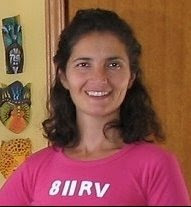3/24/2009
The Successes and Shortcomings of The Durika Foundation
I have recently begun studying intentional communities. Just yesterday I had the wonderful opportunity to visit my first one-The Durika Foundation http://www.durika.org. The word "Durika" means Eagle's beak or Mountain of Power in the local indegenous languages. Here is a recap of the visit and my personal review of Durika.
My son, a very good friend of mine, and I began our day very early to head off to Durika. Durika is 3 hours away from home here in Costa Rica with the last 14kms taking an hour to do. Costa Rica is pretty famous for its potholes and bad roads, but the road to Durika is definitely one of the most difficult I've come across so far. Happily, my friend's old 4x4 Toyota landcruiser, although not very comfortable, was strong enough to make it up the difficult road to Durika. Nonetheless, we left early enough to miss the afternoon rains that threatened because that would have made the road even more scary to traverse. The next time I visit however, I plan on walking in and staying a while to work and explore Durika much better.
Once we arrived, we were greeted by a long time resident of Durika named Zina. She has been with Durika for 14 years-and the community has existed for 18 years. Zina, as well as the other residents that we met, seemed to be in excellent health-clear skin, slim, athletic bodies and very good emotional poise. We sat with Zina for a while as she spoke to us about Durika-its community and objectives. From what I've researched so far, most intentional communities don't last more than 4 years before internal strife tears them apart. Durika, however, has been largely successful.
From the brief description we learned from Zina, I would say that this success is based on a strong organizational and disciplined foundation. From what I gathered, meditation both individual and group form is practiced daily. Strenuous, outdoor daily activity is also cherished by the community members. Social interaction that respects both private and group activities are also well defined. Hosting of individual as well as group visitors in order to interact with the outside world is an important part of the community's life. Outside communication with telephone and internet plays a key role. A clean and natural setting is obviously priceless to the community.
Learning new skills is also incorporated into the community's life. For instance, all the members are trained firefighters to help out with out of control, human caused fires that frequently occur. These fires are the result of the horrible slash and burn animal agricultural practices that are rampant in the area, which are causing massive environmental destruction. The community members are also trained in environmental protection to help fend off the often violent hunters that plague the forests with their dogs and have even shot at one of the residents.
Another strong success point is that the community has the common goal of purchasing more land for conservation and protection. So far, they have admirably been able to purchase a whopping 8500 hectares for private conservation! All of these factors contribute to the fine, successful example that is Durika.
Unfortunately, from a natural hygiene perspective, Durika has some shortcomings that prevent me from qualifying it as the ideal intentional community model to be followed. First off, they follow a lacto-ovo vegetarian, mostly, cooked diet. They have only managed to learn how to successfully grow garden vegetables. At least they are organic, very delicious as well as nutritious no doubt. Fruit is mostly imported from the outside and it doesn't seem to play a large role in the community's diet. Although organic vegetables are a cut above most, a perma-culture fruit orchard is sadly missing from the community. They rely heavily on goat and chicken animal products that are also far from ideal. I found it distressing to visit the baby goats that were taken from their mothers immediately after birth-one of the little tykes nursed on my fingers-so sad. Grains, salt, oil and vinegar-which we know have huge environmentally as well as health destroying properties-are also a large contribution to the diet.
One good point is that they do practice calorie restriction-with strict rationing of the community's products. For example, only one cup of goat's milk is generally allowed per day. Ironically, they give more to children and older people under the mistaken notion that it helps with bones; whereas, it does the complete opposite. This calorie restriction is a good thing considering the overall poor quality of the diet.
Finally, the "alternative" health practices of the community are truly just the flip side of the exact same allopathic medicine practiced by conventional doctors. Although the community practices a mostly hygienic lifestyle that prevents disease and keeps its members largely healthy-they don't seem to have connected all the dots of the health picture. For instance, herbs and "natural" remedies that are administered intravenously are practiced.
Despite its imperfections, I enjoyed my visit to Durika. The Foundation is doing a lot of fine work that although needs some refining is laudable nonetheless. I wish Durika a long life and may it continue to grow and evolve into something even better.
My son, a very good friend of mine, and I began our day very early to head off to Durika. Durika is 3 hours away from home here in Costa Rica with the last 14kms taking an hour to do. Costa Rica is pretty famous for its potholes and bad roads, but the road to Durika is definitely one of the most difficult I've come across so far. Happily, my friend's old 4x4 Toyota landcruiser, although not very comfortable, was strong enough to make it up the difficult road to Durika. Nonetheless, we left early enough to miss the afternoon rains that threatened because that would have made the road even more scary to traverse. The next time I visit however, I plan on walking in and staying a while to work and explore Durika much better.
Once we arrived, we were greeted by a long time resident of Durika named Zina. She has been with Durika for 14 years-and the community has existed for 18 years. Zina, as well as the other residents that we met, seemed to be in excellent health-clear skin, slim, athletic bodies and very good emotional poise. We sat with Zina for a while as she spoke to us about Durika-its community and objectives. From what I've researched so far, most intentional communities don't last more than 4 years before internal strife tears them apart. Durika, however, has been largely successful.
From the brief description we learned from Zina, I would say that this success is based on a strong organizational and disciplined foundation. From what I gathered, meditation both individual and group form is practiced daily. Strenuous, outdoor daily activity is also cherished by the community members. Social interaction that respects both private and group activities are also well defined. Hosting of individual as well as group visitors in order to interact with the outside world is an important part of the community's life. Outside communication with telephone and internet plays a key role. A clean and natural setting is obviously priceless to the community.
Learning new skills is also incorporated into the community's life. For instance, all the members are trained firefighters to help out with out of control, human caused fires that frequently occur. These fires are the result of the horrible slash and burn animal agricultural practices that are rampant in the area, which are causing massive environmental destruction. The community members are also trained in environmental protection to help fend off the often violent hunters that plague the forests with their dogs and have even shot at one of the residents.
Another strong success point is that the community has the common goal of purchasing more land for conservation and protection. So far, they have admirably been able to purchase a whopping 8500 hectares for private conservation! All of these factors contribute to the fine, successful example that is Durika.
Unfortunately, from a natural hygiene perspective, Durika has some shortcomings that prevent me from qualifying it as the ideal intentional community model to be followed. First off, they follow a lacto-ovo vegetarian, mostly, cooked diet. They have only managed to learn how to successfully grow garden vegetables. At least they are organic, very delicious as well as nutritious no doubt. Fruit is mostly imported from the outside and it doesn't seem to play a large role in the community's diet. Although organic vegetables are a cut above most, a perma-culture fruit orchard is sadly missing from the community. They rely heavily on goat and chicken animal products that are also far from ideal. I found it distressing to visit the baby goats that were taken from their mothers immediately after birth-one of the little tykes nursed on my fingers-so sad. Grains, salt, oil and vinegar-which we know have huge environmentally as well as health destroying properties-are also a large contribution to the diet.
One good point is that they do practice calorie restriction-with strict rationing of the community's products. For example, only one cup of goat's milk is generally allowed per day. Ironically, they give more to children and older people under the mistaken notion that it helps with bones; whereas, it does the complete opposite. This calorie restriction is a good thing considering the overall poor quality of the diet.
Finally, the "alternative" health practices of the community are truly just the flip side of the exact same allopathic medicine practiced by conventional doctors. Although the community practices a mostly hygienic lifestyle that prevents disease and keeps its members largely healthy-they don't seem to have connected all the dots of the health picture. For instance, herbs and "natural" remedies that are administered intravenously are practiced.
Despite its imperfections, I enjoyed my visit to Durika. The Foundation is doing a lot of fine work that although needs some refining is laudable nonetheless. I wish Durika a long life and may it continue to grow and evolve into something even better.
Subscribe to:
Post Comments (Atom)








3 comments:
How many people live there? What are the requirements to join? How do they make money? Is property/money shared?
Andrew, I can't be precise, but I believe there are presently around 100 full-time residents-all of them Costa Rican nationals or legal foreign residents of Costa Rica-like Zina who is originally from England, but is now a resident. As to the requirements to join, it is most likely like everything else-a group decision.
Most likely the person is permitted to stay for a short time and then the group judges whether to accept the person or not. All major decisions must be unanimously decided upon.
The group also rotates responsibilities, so that people are not always doing the same thing-unless they truly prefer a certain job-like gardening or tending to the goats.
They make money from the "health" tourists that visit and stay there for the services. They also host individual as well as group ecological tourists from all over the world-many from hugely rich families who need "rehabilitation". When we arrived there was a large group of Canadian college students just leaving after having spent a week there. They also sell some organic products.
From what I gathered, all of the funds go to the Foundation. Then the group unanimously decides how to manage them. They live very simply, with little to no personal possessions. All the surplus profit goes towards buying more land.
Interesting stuff n'est-ce pas?
It is. I find intentional communities fascinating, and if I ever find one that strikes me as pretty ideal I may try one out.
Post a Comment